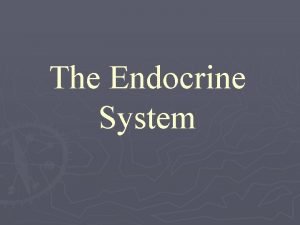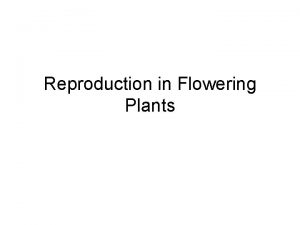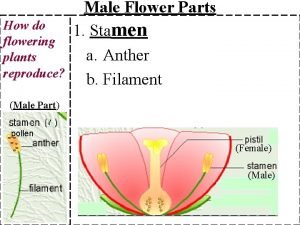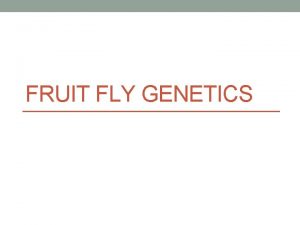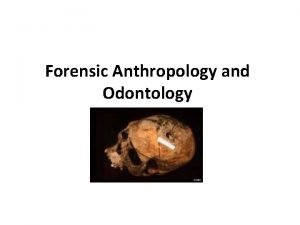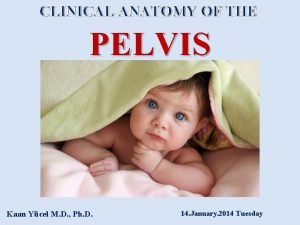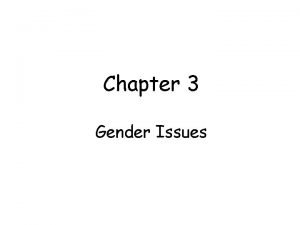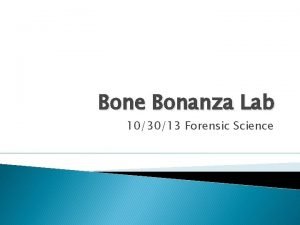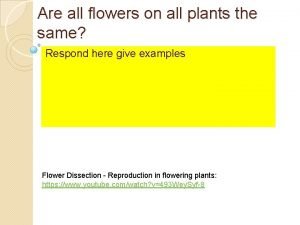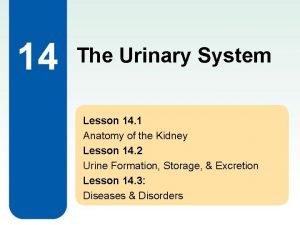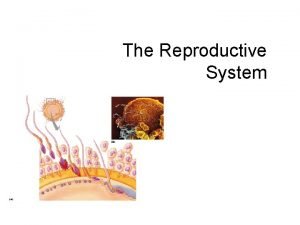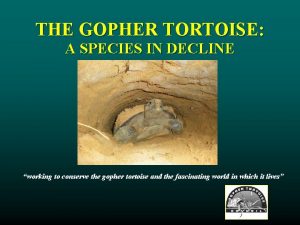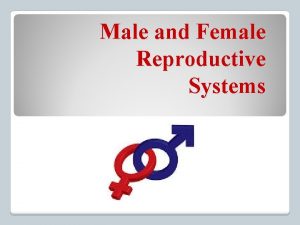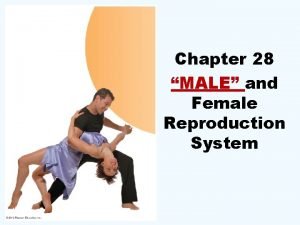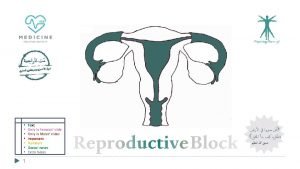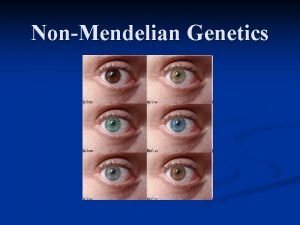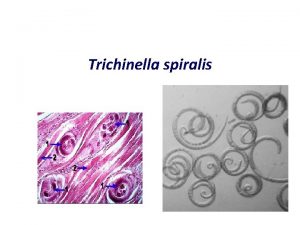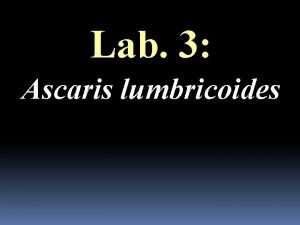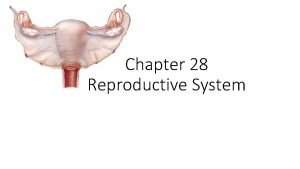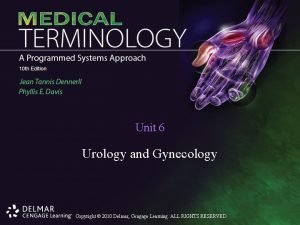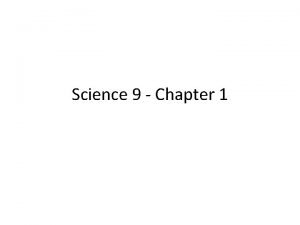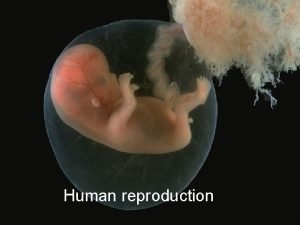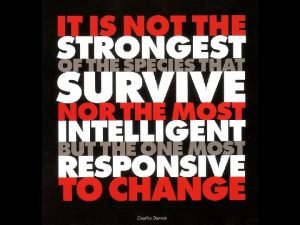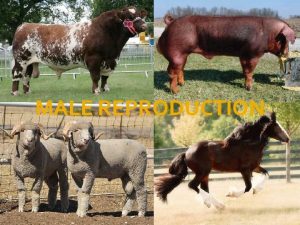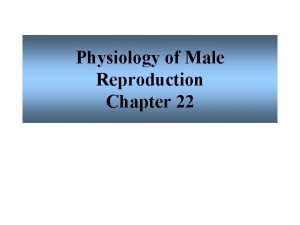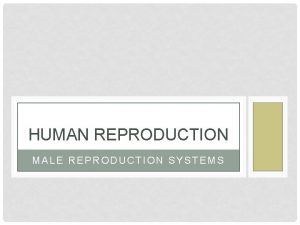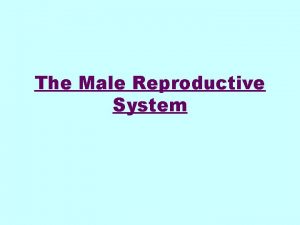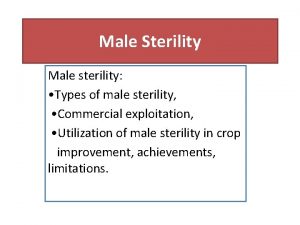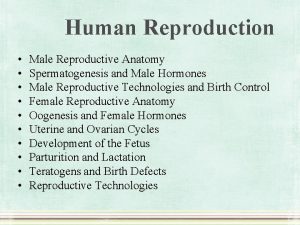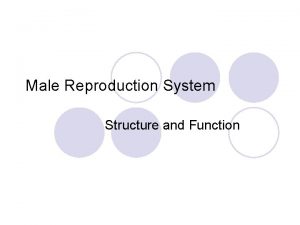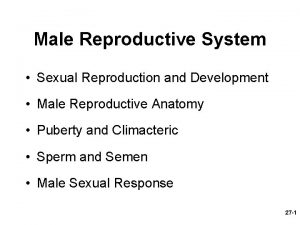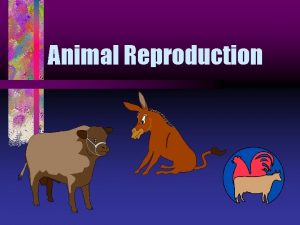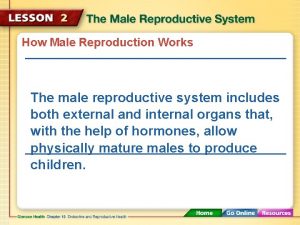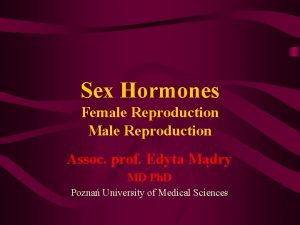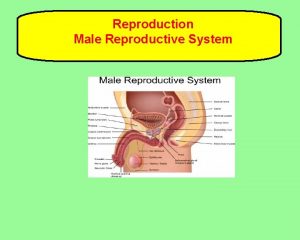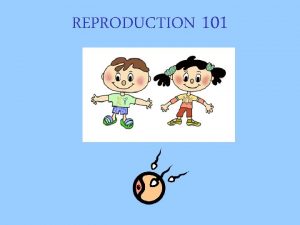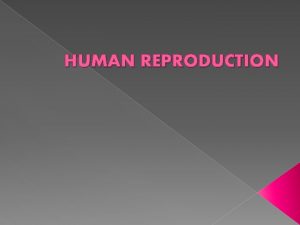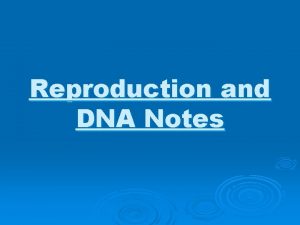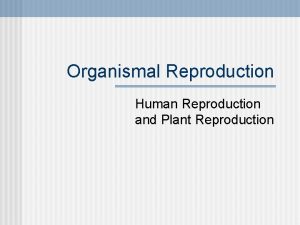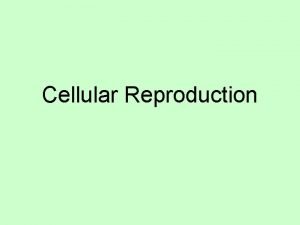Reproduction 6 6 and 11 4 Reproduction Male










































- Slides: 42

Reproduction 6. 6 and 11. 4 Reproduction

Male Anatomy

Alternate View

Male Hormones � Fun Fact: Men can be fertile until 94 years! � Testasterone › Determines the development of male gentalia during embryonic development › Ensures the development of secondary sex characteristics during puberty › Maintains the sex drive of males throughout their lifetime

Testes Tissue The seminferous tubule is where the sperm cells are produced.

Testes Tissue � Leydig/Interstitial Cells: produce the male sex hormone, testosterone � Germanal Epithelium Cells: will divide by mitosis to make spermatagonia � Developing Spermazoa: carrier of gentic material in the formation of zygotes � Sertoli Cells: will provide the spermazoa with nutrients for development

Spermatogenesis

Spermatogenesis Cells in germinal epithelium divide by mitosis � These cells are pushed toward the center of the seminiferous tubes, then grow � Divide by meiosis to form two haploid cells � Another division occurs in each haploid cell � Thus four cells are produced and attach to a Sertoli cell where they are nourished �

Hormones in Spermatogenesis � Leutinizing Hormone (LH): stimulates Leydig cells to produce testosterone � Follicle Stimulating Hormone (FSH) and Testaterone: stimulate the meiotic divisions of spermatagonia into spermatazoa

Mature Sperm Fun Fact: the average male ejaculates between 2 and 5 m. L of semen and there anywhere between 50 and 130 million sperm in each milliliter.

Sperm Route � � � � Sperm cells are carried through the lumen in the seminiferous tubules then… Are stored and gain motility in the epididymis. Upon arousal, the sperm moves up the vas deferens into the sperm duct The seminal vesicle pumps fluid (containing high fructose levels to help sperm respirate) into the sperm duct. The sperm duct travels into the prostate gland… The prostate adds alkaline (basic) fluid to help the sperm resist the acidity of the vagina. Then it exits the male from the prostate and out the urethra.

Side Note: � The bulbourethral gland is located along the urethra and below the prostate. � Prior to ejaculation, the gland secretes a clear mucus. � The mucus neutralizes any acidic urine left in the urethra. � Fun Fact: The mucus does contain some sperm which is why the pullout method of birth control has a high failure rate.

Female Anatomy

Head On View

Hormones in Menstrual Cycle Animation: https: //www. youtube. com/watch? v=l_w. X 285 vrr. U

Hormone Changes

Diagram of Ovary

Function of Ovary Parts The ovary contains follicles in various stages of development Egg cells within primordial follicles have been arrested in prophase I and have yet to undergo meiotic division � Egg cells within mature follicles have begun meiotic division and are released from the ovary as secondary oocytes (arrested in prophase II) � The ruptured follicle develops into a corpus luteum that will, in time, degenerate into a corpus albicans � The germline epithelium functions as an epithelial layer separating ovarian tissue from the rest of the body - it is not involved in oocyte development � �

Oogenesis The second meiotic division is not completed until fertilization.

Processes Involved in Oogenesis � � � � � Oogenesis describes the production of female gametes (ova) within the ovary The process begins during foetal development, when a large number of cells (oogonia) are formed by mitosis before undergoing a period of growth These cells begin meiosis but are arrested in prophase I until puberty At puberty, some follicles continue to develop each month is response to FSH secretion These follicles complete the first meiotic division to form two cells of unequal size The cell with less cytoplasm is a polar body (which degenerates), while the larger cell forms a secondary oocyte The secondary oocyte begins the second meiotic division but is arrested in prophase II (until fertilisation) It is released from the ovary (ruptured follicle develops into corpus luteum) and, if fertilisation occurs, will complete meiosis The second meiotic division will produce an ovum and a second polar body

Mature Egg

Fertilization

In-Vitro Fertilization

In-Vitro Fertilization (IVF) � � � � � For a period of three weeks, the women has to have a drug injected to stop her normal menstrual cycle. After these three weeks, high doses of FSH are injected once a day for 10 -12 days so that many follicles develop in the ovaries of the women. HCG (another hormone) is injected 36 hours before the collection of the eggs. HCG loosens the eggs in the follicles and makes them mature. The man needs to ejaculate into a jar so that sperm can be collected from the semen. The sperm are processed to concentrate the healthiest ones. A device that is inserted through the wall of the vagina is used to extract the eggs from the follicles. Each egg is then mixed with sperm in a shallow dish. The dishes are then put into an incubator overnight. The next day the dishes are looked at to see if fertilization has happened. If fertilization has been successful, two or three of the embryos are chosen to be placed in the uterus by the use of a long plastic tube. A pregnancy test is done a few weeks later to find out if any of the embryos have implanted. A scan is done a few weeks later to find out if the pregnancy is progressing normally.

Ethical Issues of IVF Arguments for IVF Arguments against IVF Many types of infertility are due to environmental factors The infertility of the parents may be inherited by their rather than genetic which means that the offspring would offspring passing on the suffering to the next generation. not inherit the infertility. The embryos that are killed during the IVF process cannot feel pain or suffering as they do not have a developed nervous system. More embryos are produced than needed and the ones that remain are usually killed which denies them the chance of a life. Embryologists select which embryos will be placed into Suffering caused by genetic diseases can be decreases the uterus. Therefore they decide the fate of new by screening the embryos before placing them into the individuals as they choose which ones will survive and uterus. which ones will die. Since the IVF process is not an easy one emotionally and physically, is costly, takes time and there are no IVF is not a natural process which takes place in a guarantees, parents who are willing to go through it must laboratory compared to natural conception which occurs as a result of an act of love. have a strong desire to have children and therefore are likely to be loving parents. Infertility can cause emotional suffering to couples who want to have children. IVF can take away this suffering for some of those couples. Infertility should be accepted as God’s will and to go against it by using IVF procedures would be wrong.

Compare Spermatogenesis and Oogenesis � Similarities: � Both processes result in the formation of haploid gametes � Both processes involve mitosis, growth and meiosis

Differences

Process of Fertilization

Process of Fertilization When the sperm enters the female reproductive tract, biochemical changes to the sperm occur in the final part of its maturation (capacitation) � The sperm is attracted to the egg due to the release of chemical signals from the secondary oocyte (chemotaxis) � Fertilisation generally occurs in the oviduct (fallopian tube) � To enter the egg membrane, the sperm must penetrate the protective jelly coat (zona pellucida) surrounding the egg via the acrosome reaction � › The acrosome vesicle fuses with the jelly coat and releases digestive enzymes which soften the glycoprotein matrix The membrane of the egg and sperm then fuse and the sperm nucleus (and centriole) enters the egg � To prevent other sperm from penetrating the fertilised egg (polyspermy), the jelly coat undergoes biochemical changes via the cortical reaction � › � The cortical granules release enzymes that destroy the sperm-binding proteins on the jelly coat Now fertilised, the nucleus of the secondary oocyte completes meiosis II and then the egg and sperm nuclei fuse to form a diploid zygote

Role of HCG in Pregnancy Fun Fact: Human chorionic gonadotrophin, this is what is tested in pregnancy tests.

HCG � � � The endometrium is a blood-rich environment in which an implanted zygote can grow and it is sustained by the hormone progesterone If progesterone levels aren't maintained (i. e. the corpus luteum degenerates), then the endometrium will be sloughed away (menstruation) A fertilised zygote develops into a blastocyst that secretes human chorionic gonadotrophin (h. CG) h. CG maintains the corpus luteum post-ovulation so that the blastocyst can remain embedded in the endometrium and continue to develop Gradually the placenta develops and produces progesterone (at around 8 - 10 weeks), at which point the corpus luteum is no longer needed

Early Embryo Development

Early Embryo Development After fertilisation, the zygote undergoes several mitotic divisions to create a solid ball of cells called a morula (at around 4 days) � Unequal divisions beyond this stage cause a fluidfilled cavity to form in the middle - this makes a blastocyst (at around 5 days) � The blastocyst consists of: � › An inner mass of cells (this will develop into the embryo) › An outer layer called the trophoblast (this will develop into the placenta) › A fluid filled cavity (called the blastocoele) These developments all occur as the developing embryo is moving from the oviduct to the uterus � When the blastocyst reaches the uterus, it will embed in the endometrium (implantation) �

Role of the Placenta

Structure and Function of Placenta � � � The placenta is a disc-shaped structure that nourishes the developing embryo It is formed from the development of the trophoblast upon implantation and eventually invades the uterine wall The umbilical cord connects the fetus to the placenta and maternal blood pools via open ended arterioles into intervillous spaces (lacunae) Chorionic villi extend into these spaces and facilitate the exchange of materials between the maternal blood and fetal capillaries Nutrients, oxygen and antibodies will be taken up by the fetus, while carbon dioxide and waste products will be removed The placenta is expelled from the uterus after childbirth

Hormonal Role of Placenta The placenta also takes over the hormonal role of the ovary (at around 12 weeks) � Estrogen stimulates growth of the muscles of the uterus (myometrium) and the development of the mammary glands � Progesterone maintains the endometrium, as well as reduces uterine contractions and maternal immune response (no antibodies against fetus) � Both estrogen and progesterone levels drop near time of birth �

Role of Amniotic Fluid The fetus develops in a fluid-filled space called the amniotic sac � Amniotic fluid is largely incompressible and good at absorbing pressure, and so protects the child from impacts to the uterine wall � The fluid also creates buoyancy so that the fetus does not have to support its own body weight while the skeletal system develops � Finally, amniotic fluid prevents dehydration of the tissues, while the amniotic sac provides an effective barrier against infection �

Fetus.

Material Exchange Between Mother and Fetus The fetus relies on the exchange of materials across the placental wall to grow and develop:

Birth and Hormonal Control

Child Birth! � � � � � The process of childbirth is called parturition and is controlled by the hormone oxytocin After nine months, the fetus is fully grown and takes up all available space in the uterus, stretching the walls of the uterus This causes a signal to be sent to the brain, releasing oxytocin from the posterior pituitary Oxytocin inhibits progesterone, which was inhibiting uterine contractions Oxytocin also directly stimulates the smooth muscle of the uterine wall to contract, initiating the birthing process The contraction of the uterine wall causes further stretching, which triggers more oxytocin to be released (causing even more contraction) Additionally, the fetus responds to the cramped conditions by releasing prostaglandins which cause further myometrial contractions As the stimulus causing oxytocin release is increased by the effects of oxytocin, this creates a positive feedback pathway Contractions will stop when labour is complete and the baby is birthed (no more stretching of the uterine wall)

Final Thoughts! http: //www. youtube. com/watch? v=Xath 6 k. Of 0 NE http: //www. youtube. com/watch? v=s. Pk_WM 1 ki 4 s
 Sexual reproduction and asexual reproduction
Sexual reproduction and asexual reproduction Sexual reproduction vs asexual reproduction venn diagram
Sexual reproduction vs asexual reproduction venn diagram Asexual vs sexual reproduction venn diagram
Asexual vs sexual reproduction venn diagram Function of male reproductive system
Function of male reproductive system Male and female reproductive system
Male and female reproductive system Major endocrine glands male and female
Major endocrine glands male and female Chapter 16 matching questions 20-24
Chapter 16 matching questions 20-24 Male fallopian tube
Male fallopian tube Part of flower that produces pollen
Part of flower that produces pollen X-linked recessive punnett square
X-linked recessive punnett square Male and female part of a flower
Male and female part of a flower What part of the flower makes pollen
What part of the flower makes pollen Difference between male and female fruit flies
Difference between male and female fruit flies Sciatic notch male vs female
Sciatic notch male vs female Blunt or sharp
Blunt or sharp Male part of a flower
Male part of a flower Bispinous diameter
Bispinous diameter Sex male and female
Sex male and female Bone bonanza a lab on male and female skeletons answer key
Bone bonanza a lab on male and female skeletons answer key Difference between male and female sharks
Difference between male and female sharks All flowers photo
All flowers photo What do male ladybugs look like
What do male ladybugs look like Lesson 14.2 male and female urinary structures
Lesson 14.2 male and female urinary structures Tools and materials in making simple electrical gadgets
Tools and materials in making simple electrical gadgets Similarities between male and female reproductive system
Similarities between male and female reproductive system Wiregrass
Wiregrass Male and female hormones
Male and female hormones 90/2
90/2 Male and female hormones
Male and female hormones Codominance
Codominance Trichinella spiralis egg morphology
Trichinella spiralis egg morphology An 82 kg male and a 48 kg female
An 82 kg male and a 48 kg female Ascaris lumbricoides female cross section
Ascaris lumbricoides female cross section Uterine orifice
Uterine orifice Copyright
Copyright Parthenogenesis asexual reproduction
Parthenogenesis asexual reproduction Human development cycle
Human development cycle Male fish reproductive system
Male fish reproductive system Mammary papilla fetal pig
Mammary papilla fetal pig Sexual reproduction and genetics section 1 meiosis
Sexual reproduction and genetics section 1 meiosis Unequal survival and reproduction that results from the
Unequal survival and reproduction that results from the Organisms that reproduce asexually
Organisms that reproduce asexually Mendelian genetics
Mendelian genetics





